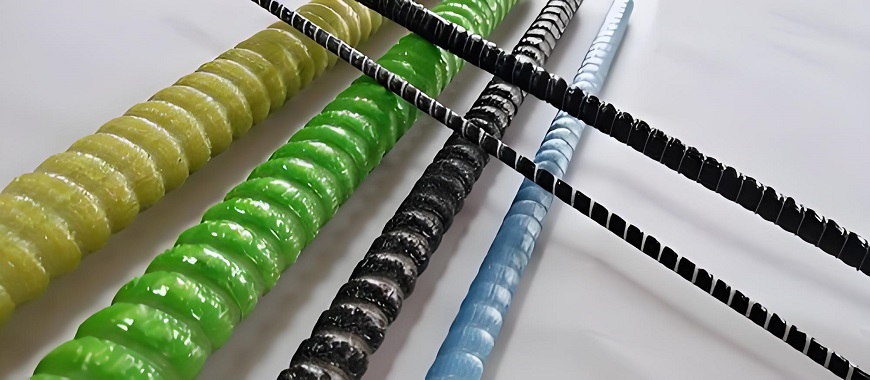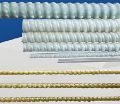
Structural reinforcement is essential in concrete applications like bridges, parking garages, and driveways to enhance durability and longevity. Traditionally, steel rebar has been widely used for its strength, yet it presents limitations such as susceptibility to corrosion and high maintenance costs. Recently, fiberglass instead of rebar has gained attention as an alternative, offering unique benefits for concrete structures. Fiberglass rebar is lightweight, resistant to corrosion, and requires minimal upkeep, making it suitable for various environments. Its high strength-to-weight ratio and flexibility allow for diverse applications, driving a growing interest in fiberglass instead of rebar. This shift is due to the potential for long-term cost savings and improved performance in challenging conditions.
Why Choose Fiberglass Instead of Rebar?
Fiberglass instead of rebar is becoming a preferred option in concrete reinforcement due to its durability and ease of maintenance. Traditional steel rebar often faces issues with corrosion and high upkeep, while fiberglass offers a long-term, cost-effective solution. The benefits of fiberglass make it a valuable choice for diverse concrete projects.
Fiberglass Instead of Rebar Pros and Cons
Fiberglass instead of rebar offers distinct advantages that set it apart from steel, though it also comes with certain limitations. Understanding these pros and cons can help make informed decisions about its use.
- Benefits of Fiberglass Instead of Rebar:
- High strength-to-weight ratio, reducing structural load
- Resistance to corrosion, even in harsh environments
- Low maintenance requirements, leading to long-term cost savings
- Electrical and thermal non-conductivity, which prevents interference in sensitive areas
- Lightweight, making transport and installation easier
- Flexibility for a variety of custom applications
- Disadvantages of Fiberglass Rebar Compared to Steel Rebar:
- Higher initial cost compared to traditional steel
- Limited experience and case studies in extremely high-load applications
- Different handling and installation techniques may require additional training
- Less resistance to very high temperatures
| Factors | Fiberglass Instead of Rebar | Steel Rebar |
|---|---|---|
| Corrosion Resistance | Excellent, non-corrosive | Susceptible to rust, requires coatings |
| Maintenance | Minimal maintenance needed | Regular inspection and repair needed |
| Weight | Lightweight, easy to handle | Heavy, costly to transport and install |
| Cost | Higher initial cost, lower life-cycle cost | Lower upfront cost, higher upkeep |
| Conductivity | Non-conductive | Conductive, can interfere with electrical systems |
| Application Flexibility | Adaptable to custom projects | Limited flexibility |
Fiberglass Instead of Rebar for Driveways and Small Projects
Fiberglass instead of rebar is increasingly used for smaller applications like driveways and sidewalks, where durability and low maintenance are essential. These projects benefit from fiberglass’s unique properties, making it a strong alternative to steel in several ways.
- Suitability Factors for Fiberglass Instead of Rebar in Driveways:
- Weather Resistance: Fiberglass resists moisture and salt, making it ideal for outdoor surfaces exposed to rain, snow, or road salt.
- Durability: The non-corrosive nature of fiberglass enhances longevity, reducing cracking and wear in concrete surfaces.
- Cost: Although initially higher, fiberglass’s low maintenance costs can make it more affordable over time.
Using fiberglass instead of rebar in driveways can also benefit projects where fast installation is essential, as it requires less labor and equipment for handling. Ensuring precise fiberglass rebar detailing during the planning and installation phases helps maximize its structural advantages, providing long-term stability and reducing vulnerability to environmental impacts. With careful fiberglass rebar detailing, this alternative material is becoming increasingly popular in small-scale projects that demand both efficiency and durability.
Why Rebar Material is Key for Structural Strength
Comparing Fiberglass Instead of Rebar Costs
When evaluating fiberglass instead of rebar, cost is a crucial factor. While fiberglass rebar may have a higher initial cost than steel, its long-term savings and low maintenance make it a competitive choice in many applications. Feedback from fiberglass rebar reviews often highlights its durability and resistance to corrosion, reinforcing its value in projects where longevity is a priority. A thorough cost comparison helps reveal the economic advantages of fiberglass in various construction projects, particularly when considering reduced upkeep and extended service life.
Fiberglass Instead of Rebar Price Considerations
The price considerations for fiberglass instead of rebar include both initial costs and long-term benefits. While upfront costs are typically higher for fiberglass, several factors can influence its overall value.
- Initial Costs:
- Higher production costs than traditional steel
- Specialized manufacturing processes contribute to a higher price
- Initial investment may be offset by reduced installation and transportation costs
- Long-Term Maintenance Savings:
- Fiberglass is non-corrosive, reducing the need for protective coatings
- Minimal maintenance required due to resistance to moisture and chemicals
- Fewer repairs needed, leading to long-term cost savings in maintenance budgets
- Extended lifespan helps avoid costly replacements common with steel
- Lifecycle Cost Analysis:
- Projects using fiberglass instead of rebar experience fewer interruptions for maintenance
- Reduced environmental wear results in savings over decades, especially in harsh conditions
- Lower frequency of inspection and repair contributes to budget efficiency
These price considerations suggest that fiberglass, despite its initial cost, may be a more economical choice for projects aiming for longevity and low maintenance.
Fiberglass Rebar vs Steel Price Comparison
To understand the cost differences between fiberglass and steel, it’s essential to compare initial and lifecycle costs. This comparison highlights fiberglass instead of rebar as a viable investment for long-term applications.
| Cost Factors | Fiberglass Instead of Rebar | Steel Rebar |
|---|---|---|
| Initial Material Cost | Higher than steel due to specialized manufacturing | Lower initial cost; widely available |
| Transportation Cost | Lower, due to lightweight composition | Higher, as steel is heavier and harder to transport |
| Installation Cost | Lower, as lightweight fiberglass reduces labor and time | Higher, requiring more labor for placement |
| Maintenance Costs | Minimal; resists corrosion and chemicals | Significant; requires regular inspection and rust-proofing |
| Lifecycle Costs | Lower overall, with extended lifespan and fewer repairs | Higher, with frequent maintenance and potential replacement |
| Application Suitability | Ideal for long-term projects in corrosive or high-moisture areas | Suitable for short-term projects or areas with low corrosion risk |
This cost breakdown demonstrates that while fiberglass instead of rebar requires a higher upfront investment, its low maintenance, lightweight design, and durability contribute to lower overall costs in the long run.
Pink Rebar vs Steel Rebar: Pros and Cons
Potential Trade-offs of Using Fiberglass Instead of Rebar
Choosing fiberglass instead of rebar has several benefits, but it’s important to consider potential trade-offs in specific construction scenarios. In some cases, traditional steel rebar may still offer advantages that fiberglass cannot fully match. This section examines factors that may limit fiberglass’s suitability for structural reinforcements.
Disadvantages of Fiberglass Rebar in Structural Reinforcements
Despite its advantages, fiberglass instead of rebar may not suit every structural application. Here are some common drawbacks to consider:
- Load-Bearing Capacity:
- Fiberglass rebar typically has a lower tensile strength than steel, making it less effective in high-stress applications.
- In projects requiring heavy load-bearing, like high-rise buildings, steel rebar may still be preferred.
- Fiberglass’s performance under extreme pressure or heavy loads lacks extensive research, limiting its use in heavy-duty applications.
- Cost Considerations:
- The initial cost of fiberglass instead of rebar is generally higher, especially for large-scale projects.
- Budget limitations may discourage the use of fiberglass in applications where steel offers a more affordable solution. While matte fiberglass provides durability and corrosion resistance, decision-makers must weigh these benefits against the overall project costs.
- Cost-effectiveness depends on factors like the project size, location, and available funding.
- Thermal Resistance:
- Fiberglass has limited thermal resistance compared to steel, which can be an issue in high-temperature environments. While durable fiberglass rebar provides excellent strength and corrosion resistance, prolonged exposure to extreme heat may affect its performance.
- Applications where exposure to high heat is expected, such as industrial facilities, may find fiberglass less reliable.
- In areas prone to high-temperature fluctuations, fiberglass rebar’s durability may be reduced over time.
- Case Examples Where Steel May Be Preferred:
- Industrial Structures: Steel remains a safer choice for structures exposed to intense heat or heavy machinery.
- Heavy Infrastructure: For projects like dams or high-capacity bridges, steel’s load-bearing abilities are crucial.
- Low-Budget Projects: In scenarios with limited budgets, steel may offer a more cost-effective option than fiberglass.
While fiberglass instead of rebar can offer unique advantages, understanding these limitations ensures the right material is selected for each specific project need.
Rebar Fiberglass vs Steel: Which Is Right for Your Project?
Long-Term Benefits of Choosing Fiberglass Instead of Rebar
Selecting fiberglass instead of rebar offers several long-term advantages that can significantly impact the durability and cost-effectiveness of a project. Its unique properties, particularly in challenging environments, make fiberglass a viable option for many construction applications. This section explores the benefits of fiberglass in high-corrosion settings and how its low maintenance needs reduce overall project costs.
Fiberglass Rebar in High-Corrosion Environments
Fiberglass instead of rebar is especially effective in environments with high moisture, salt exposure, or chemical presence. These conditions can quickly degrade traditional steel rebar, leading to costly repairs and replacements.
- Corrosion Resistance:
- Fiberglass rebar is inherently resistant to corrosion, making it ideal for coastal structures exposed to saltwater. In regions where infrastructure longevity is a priority, fiberglass rebar ontario has been utilized in various projects to enhance durability and minimize maintenance costs.
- In settings like wastewater treatment plants, where chemical exposure is constant, fiberglass rebar provides a durable solution.
- Fiberglass’s lack of reactivity with moisture helps preserve structural integrity, reducing issues like concrete cracking.
- Case Examples in High-Corrosion Areas:
- Bridges in Coastal Areas: Fiberglass instead of rebar is used in bridges exposed to saltwater, extending their lifespan and reducing maintenance costs.
- Marine Facilities: Piers and docks in saltwater benefit from fiberglass rebar’s corrosion resistance, leading to more durable installations. The use of fiberglass rebar mesh in these structures helps distribute loads effectively while maintaining resistance to moisture-related deterioration.
- Chemical Plants: Structures that frequently encounter chemicals benefit from fiberglass’s resistance, limiting costly repairs.
- Research Supporting Fiberglass in Corrosive Environments:
- Studies show that fiberglass rebar retains its strength even after prolonged exposure to harsh elements, making it a strong contender for high-corrosion environments.
- Data from marine construction projects indicate that fiberglass maintains structural integrity longer than steel under similar conditions.
Fiberglass Instead of Rebar for Reducing Maintenance Costs
Choosing fiberglass instead of rebar can significantly reduce maintenance costs over a structure’s lifecycle, which is a critical consideration for budget-conscious projects. Fiberglass’s durability against environmental factors means fewer interventions are required, leading to long-term savings.
- Low Maintenance Requirements:
- Fiberglass rebar resists rust and does not require regular protective coatings, unlike steel.
- Minimal upkeep makes fiberglass an attractive choice for remote or difficult-to-access locations where regular maintenance is challenging.
- Fiberglass’s stability in diverse conditions prevents issues like spalling, reducing the need for costly repairs.
- Cost-Effectiveness for Long-Term Projects:
- Fiberglass rebar’s longevity reduces the frequency of replacements, making it a cost-effective investment for long-lasting projects.
- Infrastructure such as bridges and parking structures benefit from fiberglass’s extended lifespan, resulting in budget savings.
- Examples of Maintenance Savings:
- Tunnels and Underground Structures: Using fiberglass instead of rebar minimizes corrosion in moist underground conditions, reducing repair expenses.
- Municipal Projects: Fiberglass rebar is increasingly chosen for projects like retaining walls and culverts, where reduced maintenance translates to substantial public savings.
The long-term benefits of fiberglass instead of rebar include enhanced corrosion resistance and lower maintenance demands, making it a strategic choice for projects aiming to maximize durability and minimize upkeep.
FAQs about Fiberglass Instead of Rebar
Yes, fiberglass can replace rebar in many applications. Fiberglass rebar, also known as glass fiber-reinforced polymer (GFRP), provides excellent corrosion resistance, lightweight properties, and a high strength-to-weight ratio, making it an effective alternative to steel rebar. Fiberglass is particularly useful in environments exposed to moisture, chemicals, or salt, where steel is prone to rust and deterioration. It performs well in structures such as bridges, parking garages, marine facilities, and water treatment plants. However, fiberglass may not be suitable for extremely high-load projects that demand maximum tensile strength, as steel rebar remains stronger in such cases. When durability, minimal maintenance, and corrosion resistance are top priorities, fiberglass can serve as a practical replacement for steel rebar. Overall, fiberglass rebar offers significant long-term benefits, especially in settings where environmental factors would otherwise compromise steel’s longevity.
Fiberglass rebar has several downsides that may limit its use in specific applications. First, fiberglass generally has a higher initial cost than steel, which may not be feasible for low-budget projects. Another drawback is its lower tensile strength compared to steel, making it less suitable for high-load applications like tall buildings or infrastructure with heavy weight demands. Fiberglass also lacks the thermal resistance of steel, making it less suitable for projects exposed to extreme heat. Additionally, because fiberglass rebar requires specific installation methods, workers may need extra training, adding to labor costs. In high-temperature settings or applications demanding maximum load-bearing capacity, traditional steel rebar may be a better fit. Lastly, although fiberglass rebar is widely used in certain areas, it still lacks the extensive testing and long-term use data that steel has, which can deter some engineers from adopting it.
Yes, fiber can be used in concrete instead of rebar for specific applications, although it depends on the project’s structural needs. Fibers like fiberglass, polypropylene, and steel fibers are often added to concrete to increase its tensile strength and reduce cracking. Fibers help create a more durable concrete mix and are beneficial in applications like sidewalks, driveways, and slabs where heavy reinforcement is not essential. However, fiber alone cannot always replace traditional rebar in projects requiring high structural integrity and load-bearing capacity. For instance, fibers may not provide the reinforcement necessary for buildings, bridges, or large infrastructure projects where rebar’s strength is crucial. While fibers can enhance concrete’s resistance to cracking and shrinkage, they work best as a supplementary measure. In smaller or non-load-bearing applications, using fiber in concrete instead of rebar may deliver effective, low-cost reinforcement.
Whether fiberglass or steel rebar is better depends on the project’s requirements and environmental conditions. Fiberglass rebar is more resistant to corrosion, making it ideal for environments exposed to moisture, salt, or chemicals. It requires less maintenance over time and is lightweight, which reduces transportation and installation costs. These qualities make fiberglass rebar a better choice for long-term durability in challenging conditions, like coastal areas or wastewater facilities. On the other hand, steel rebar offers greater tensile strength, which is essential for heavy-duty, high-load applications such as tall buildings, bridges, and dams. Steel rebar is also generally more affordable upfront and is widely used, so it benefits from extensive industry experience and testing. In situations demanding maximum load-bearing capacity and thermal resistance, steel rebar may still be the preferred option. Overall, fiberglass rebar is better suited for projects needing low maintenance and corrosion resistance, while steel is ideal for high-strength structural applications.

As the editor of GangLong Fiberglass, I have years of experience and in-depth research, focusing on cable tray products, fiberglass solutions, and grille systems. I incorporate years of industry insights and practical experience into every content, committed to promoting the progress of the industry. At GangLong Fiberglass, my commitment is reflected in every product, from innovative cable trays to durable fiberglass solutions and sturdy grille systems. As an authoritative voice in the industry, my goal is to provide valuable information to professionals and businesses and promote forward-looking solutions.


